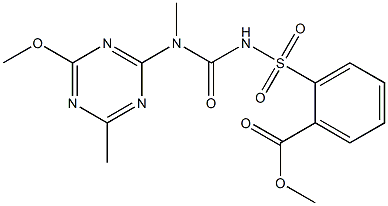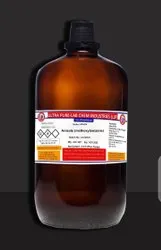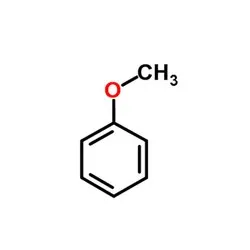Anisole
Synonym(s):Anisole;Methoxybenzene;Methyl phenyl ether;Methyl phenyl ether, Methoxybenzene
- CAS NO.:100-66-3
- Empirical Formula: C7H8O
- Molecular Weight: 108.14
- MDL number: MFCD00008354
- EINECS: 202-876-1
- SAFETY DATA SHEET (SDS)
- Update Date: 2025-12-17 09:49:49

What is Anisole?
Description
Anisole is a colorless liquid with a spicy-sweet smell. Anisole can be produced by all the aforementioned methods. It is an important intermediate in the synthesis of organic compounds, for example fragrances and pharmaceuticals. The compound is also used as a solvent and as a heat transfer medium.
Chemical properties
Anisole is a colorless to yellowish liquid with a characteristic pleasant, anise-like, agreeable, aromatic, spicy-sweet odor. It is used in perfumery.
Occurrence
Anisole is a natural product found in apple juice and in the oil of Artemisia dracunculus var. turkestanica; also reported found in butter, Camembert cheese, roasted beef, olive (Olea europae), Malay apple, Jerusalem artichoke (Helianthus tuberosus), Bourbon vanilla, truffles, crab and sopadilla fruit (Achras sapota L.).
The Uses of Anisole
Anisole is widely used as a solvent for the synthesis of various organic compounds, anethole, nonylphenol isomer 4-(3',6'-dimethyl-3-heptyl)phenol, perfumes, insect pheromones and pharmaceuticals. It finds application in the preparation of inorganic complexes and materials such as tin-core/tin oxide nanoparticles.
What are the applications of Application
Anisole is a biochemical for proteomics research
Definition
ChEBI: Anisole is a monomethoxybenzene that is benzene substituted by a methoxy group. It has a role as a plant metabolite.
Preparation
Anisole is synthesized by reacting phenol and dimethyl sulfate in the presence of aqueous NaOH; by passing methyl chloride into a suspension of sodium phenolate in liquid ammonia.
What are the applications of Application
Anisole is an organic compound with the chemical formula C7H8O with a pleasant anise-like aroma, used in organic synthesis and also as a solvent, fragrance and insect repellent. For organic synthesis, it is also used as solvent, fragrance and insect repellent.
Aroma threshold values
Detection: 50 ppb
Synthesis Reference(s)
Canadian Journal of Chemistry, 40, p. 441, 1962 DOI: 10.1139/v62-070
Journal of the American Chemical Society, 88, p. 4271, 1966 DOI: 10.1021/ja00970a037
Organic Syntheses, Coll. Vol. 1, p. 58, 1941
General Description
A clear straw-colored liquid with an aromatic odor. Insoluble in water and the same density as water. Vapors heavier than air. Flash point 125°F. Boiling point 307°F. Moderately toxic by ingestion. A skin irritant. Used to make perfumes, flavorings and as a solvent.
Air & Water Reactions
Flammable. Ethers tend to form unstable peroxides when exposed to oxygen. Ethyl, isobutyl, ethyl tert-butyl, and ethyl tert-pentyl ether are particularly hazardous in this respect. Ether peroxides can sometimes be observed as clear crystals deposited on containers or along the surface of the liquid. Insoluble in water
Reactivity Profile
Ethers, such as Anisole can act as bases. They form salts with strong acids and addition complexes with Lewis acids. The complex between diethyl ether and boron trifluoride is an example. Ethers may react violently with strong oxidizing agents. In other reactions, which typically involve the breaking of the carbon-oxygen bond, ethers are relatively inert.
Health Hazard
Inhalation or contact with material may irritate or burn skin and eyes. Fire may produce irritating, corrosive and/or toxic gases. Vapors may cause dizziness or suffocation. Runoff from fire control or dilution water may cause pollution.
Safety Profile
Moderately toxic by ingestion and inhalation. A skin irritant. A flammable liquid. To fight fire, use foam, CO2, dry chemical. When heated to decomposition it emits acrid fumes.
Potential Exposure
Anisole is used as a solvent; a flavoring, vermicide, making perfumes; and in organic synthesis.
First aid
If this chemical gets into the eyes, remove anycontact lenses at once and irrigate immediately for at least15 min, occasionally lifting upper and lower lids. Seek medical attention immediately. If this chemical contacts theskin, remove contaminated clothing and wash immediatelywith soap and water. Seek medical attention immediately. Ifthis chemical has been inhaled, remove from exposure,begin rescue breathing (using universal precautions, including resuscitation mask) if breathing has stopped and CPR ifheart action has stopped. Transfer promptly to a medicalfacility. When this chemical has been swallowed, get medical attention. Give large quantities of water and inducevomiting. Do not make an unconscious person vomit.
Storage
Color Code—Red: Flammability Hazard: Store ina flammable liquid storage area or approved cabinet away from ignition sources and corrosive and reactive materials.Prior to working with this chemical you should be trainedon its proper handling and storage. Before enteringconfined space where anisole may be present, check tomake sure that an explosive concentration does not exist.Store in tightly closed containers in a cool, well-ventilated,fireproof area. Metal containers involving the transfer ofthis chemical should be grounded and bonded. Wherepossible, automatically pump liquid from drums or otherstorage containers to process containers. Drums must beequipped with self-closing valves, pressure vacuum bungs,and flame arresters. Use only nonsparking tools and equipment, especially when opening and closing containers ofthis chemical. Sources of ignition, such as smoking andopen flames, are prohibited where this chemical is used,handled, or stored in a manner that could create a potentialfire or explosion hazard.
Shipping
Anisole requires a shipping label of“FLAMMABLE LIQUID.” Anisole falls in Hazard Class 3,Packing Group III.[19, 20]
Purification Methods
Shake anisole with half its volume of 2M NaOH, and the emulsion is allowed to separate. Repeat three times, then wash twice with water, dry over CaCl2, filter, dry over sodium wire and finally distil it from fresh sodium under N2 using a Dean-Stark trap (samples in the trap being rejected until free from turbidity) [Caldin et al. J Chem Soc, Faraday Trans 1 72 1856 1976]. Alternatively dry it with CaSO4 or CaCl2, or by refluxing with sodium or BaO with crystalline FeSO4 or by passage through an alumina column. Traces of phenols are removed by prior shaking with 2M NaOH, followed by washing with water. It has been be purified by zone refining. [Beilstein 6 IV 548.]
Incompatibilities
Incompatible with oxidizers (chlorates, nitrates, peroxides, permanganates, perchlorates, chlorine, bromine, fluorine, etc.); contact may cause fires or explosions. Keep away from alkaline materials, strong bases, strong acids, oxoacids, epoxides.
Waste Disposal
Dissolve or mix the material with a combustible solvent and burn in a chemical incinerator equipped with an afterburner and scrubber. All federal, state, and local environmental regulations must be observed.
Properties of Anisole
| Melting point: | -37 °C (lit.) |
| Boiling point: | 154 °C (lit.) |
| Density | 0.995 g/mL at 25 °C (lit.) |
| vapor density | 3.7 (vs air) |
| vapor pressure | 10 mm Hg ( 42.2 °C) |
| refractive index | n |
| FEMA | 2097 | ANISOLE |
| Flash point: | 125 °F |
| storage temp. | Store below +30°C. |
| solubility | 1.71g/l |
| form | Liquid |
| color | Clear colorless |
| Odor | phenol, anise odor |
| Relative polarity | 0.198 |
| explosive limit | 0.34-6.3%(V) |
| Odor Threshold | 0.057ppm |
| Water Solubility | 1.6 g/L (20 ºC) |
| Merck | 14,669 |
| JECFA Number | 1241 |
| BRN | 506892 |
| Dielectric constant | 4.3(20℃) |
| Stability: | Stable. Flammable. Incompatible with strong oxidizing agents. |
| CAS DataBase Reference | 100-66-3(CAS DataBase Reference) |
| NIST Chemistry Reference | Benzene, methoxy-(100-66-3) |
| EPA Substance Registry System | Anisole (100-66-3) |
Safety information for Anisole
| Signal word | Warning |
| Pictogram(s) |
 Flame Flammables GHS02  Exclamation Mark Irritant GHS07 |
| GHS Hazard Statements |
H226:Flammable liquids H336:Specific target organ toxicity,single exposure; Narcotic effects |
| Precautionary Statement Codes |
P210:Keep away from heat/sparks/open flames/hot surfaces. — No smoking. P233:Keep container tightly closed. P240:Ground/bond container and receiving equipment. P241:Use explosion-proof electrical/ventilating/lighting/…/equipment. P242:Use only non-sparking tools. P243:Take precautionary measures against static discharge. |
Computed Descriptors for Anisole
| InChIKey | RDOXTESZEPMUJZ-UHFFFAOYSA-N |
Anisole manufacturer
Triveni Interchem Private Limited (Group Of Triveni Chemicals)
New Products
4,4-Difluoropiperidine hydrochloride tert-butyl 9-methoxy-3-azaspiro[5.5]undecane-3-carboxylate Indole Methyl Resin N-Isopropylurea N,N-Dicyclohexylcarbodiimide(DCC) MELDRUMS ACID 5-METHYLISOXAZOLE-4-CARBOXYLIC ACID Magnessium Bis glycinate Zinc ascorbate 1-bromo-2-butyne 2-acetamidophenol 9(10H)-anthracenone Erythrosin B, 4-Piperidinopiperidine 2-((4-morpholinophenylamino) (methylthio) methylene) malononitrile 2,4-dihydroxybenzaldehyde 3-(4-morpholinophenylamino)-5-amino-1H-pyrazole-4-carbonitrile Methyl 2-methylquinoline-6-carboxylate 2,6-dichloro-4-nitropyridine 4-Bromo-2-chlorobenzonitrile 2-(benzylamino)acetic acid hydrochloride 4-(tert-Butoxycarbonylamino)but- 2-ynoic acid 3,4-dihydro-2H-benzo[b][1,4]dioxepine 1-Phenyl-1-cycloprppanecarboxylicacidRelated products of tetrahydrofuran








You may like
-
 Anisole 98%View Details
Anisole 98%View Details -
 Anisole (SQ) CAS 100-66-3View Details
Anisole (SQ) CAS 100-66-3View Details
100-66-3 -
 Anisole extrapure CAS 100-66-3View Details
Anisole extrapure CAS 100-66-3View Details
100-66-3 -
 Anisole extrapure AR CAS 100-66-3View Details
Anisole extrapure AR CAS 100-66-3View Details
100-66-3 -
 Anisole (methoxybenzene)View Details
Anisole (methoxybenzene)View Details
100-66-3 -
 Industrial Anisole, Packaging Size: 200 kgView Details
Industrial Anisole, Packaging Size: 200 kgView Details
100-66-3 -
 Industrial ANISOLE .View Details
Industrial ANISOLE .View Details
100-66-3 -
 99% Liquid Anisole, Grade Standard: Reagent Grade, 100-66-3View Details
99% Liquid Anisole, Grade Standard: Reagent Grade, 100-66-3View Details
100-66-3
